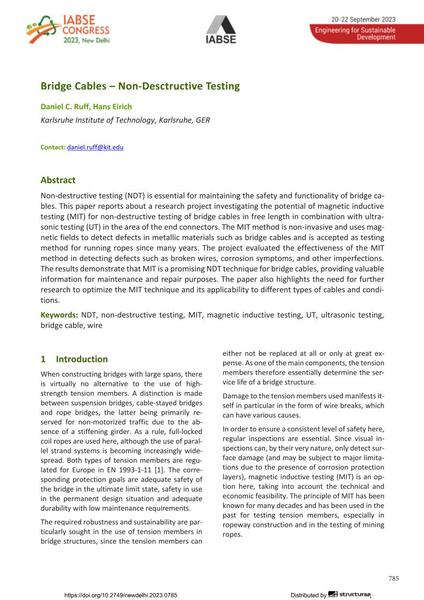Bridge Cables – Non-Desctructive Testing

|
|
|||||||||||
Bibliografische Angaben
| Autor(en): |
Daniel C. Ruff
(Karlsruhe Institute of Technology, Karlsruhe, GER)
Hans Eirich (Karlsruhe Institute of Technology, Karlsruhe, GER) |
||||
|---|---|---|---|---|---|
| Medium: | Tagungsbeitrag | ||||
| Sprache(n): | Englisch | ||||
| Tagung: | IABSE Congress: Engineering for Sustainable Development, New Delhi, India, 20-22 September 2023 | ||||
| Veröffentlicht in: | IABSE Congress New Delhi 2023 | ||||
|
|||||
| Seite(n): | 785-791 | ||||
| Anzahl der Seiten (im PDF): | 7 | ||||
| DOI: | 10.2749/newdelhi.2023.0785 | ||||
| Abstrakt: |
Non-destructive testing (NDT} is essential for maintaining the safety and functionality of bridge ca- bles. This paper reports about a research project investigating the potential of magnetic inductive testing (MIT} for non-destructive testing of bridge cables in free length in combination with ultra- sonic testing (UT} in the area of the end connectors. The MIT method is non-invasive and uses mag- netic fields to detect defects in metallic materials such as bridge cables and is accepted as testing method for running ropes since many years. The project evaluated the effectiveness of the MIT method in detecting defects such as broken wires, corrosion symptoms, and other imperfections. The results demonstrate that MIT is a promising NDT technique for bridge cables, providing valuable information for maintenance and repair purposes. The paper also highlights the need for further research to optimize the MIT technique and its applicability to different types of cables and condi- tions. |
||||
| Stichwörter: |
ZfP zerstörungsfreie Prüfung Litze
|
||||
